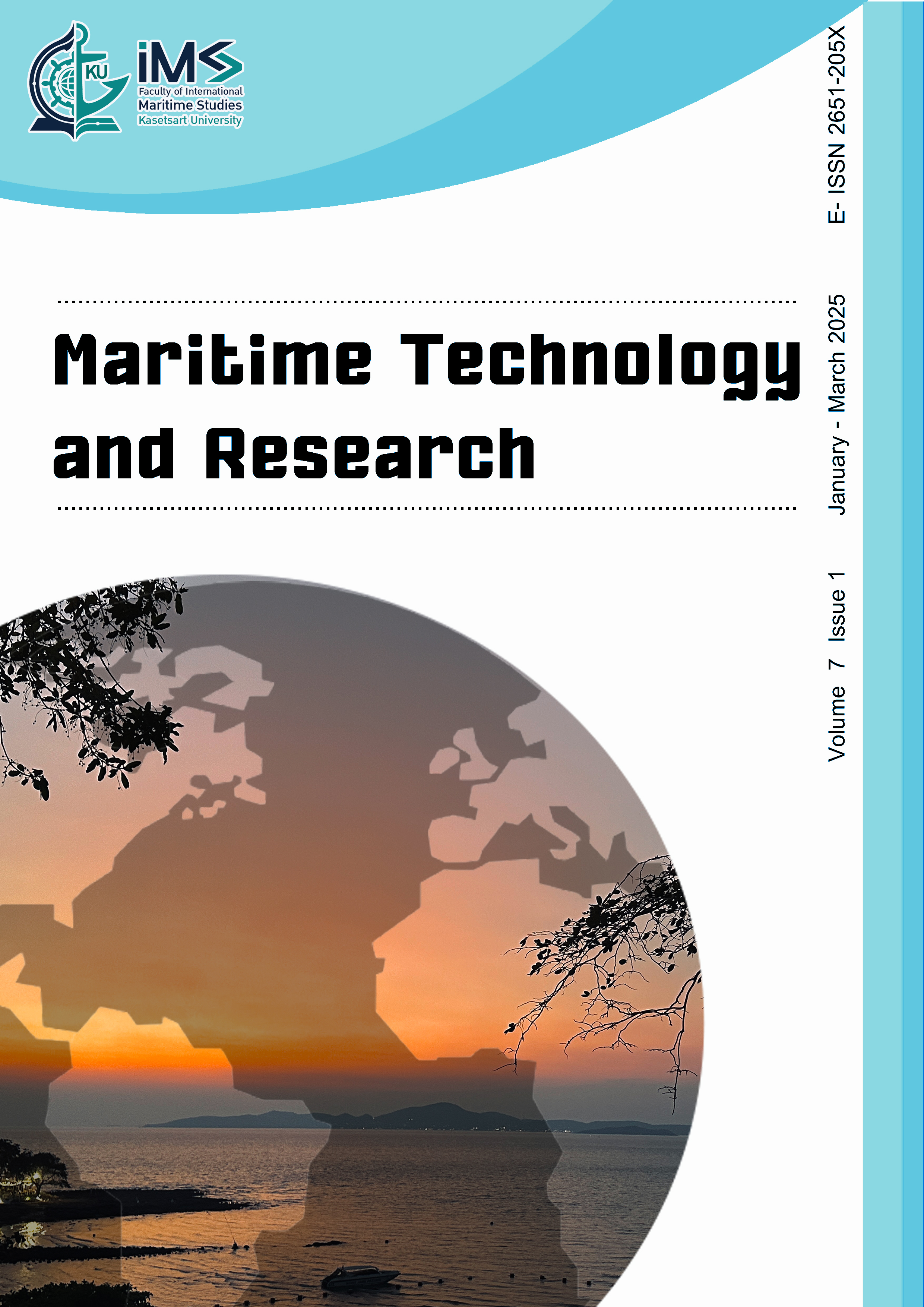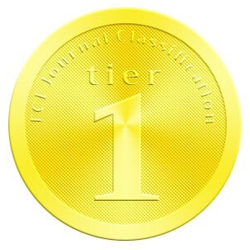Response control of TLP with single TMD under wind, wave, and current
DOI:
https://doi.org/10.33175/mtr.2025.272515Keywords:
Tension leg platform (TLP); Single-tuned mass damper (TMD); Surge control; Power Spectral Density (PSD); Phase plots; RecenteringAbstract
Offshore Tension Leg Platforms (TLP) are hybrid structures that encounter large offsets under rough sea states. They impose large displacements, resulting in operational challenges under extreme sea states. The key to safe topside operation is to minimize responses in flexible modes using appropriate control mechanisms. The present study evaluates the response control of TLP with tuned mass damper under different sea state environments. The damper is positioned such that the mass center of the primary and secondary system is concurrent. It is enabled only with surge motion, which controls the platform surge motion by tuning their frequency ratios. Response control in surge motion is assessed for different mass ratios of the damper. Results show that the RMS value of surge response is effectively reduced for a mass ratio of 0.3, while other mass ratios do not show effective control; the maximum reduction in the surge amplitude is about 26 %. The response reduction is essentially due to the phase shift between the nature of the responses with and without tuned mass damper. In addition, the damper helps improve the recentering capabilities observed from the phase plots.
------------------------------------------------------------------------------
Cite this article:
Suja, T.P., Chandrasekaran, S. (2025). Response control of TLP with single TMD under wind, wave, and current. Maritime Technology and Research, 7(1), 272515. https://doi.org/10.33175/mtr.2025.272515
------------------------------------------------------------------------------
Highlights
- TLP response control is achieved by passive damper
- The novelty is tuning of the TMD for the critical mass ratio
- It increases the operational safety and stability of the TLP and is suitable for hybrid compliant platforms like TLP
References
Abou-Rayan, A. M., & El-Gamal, A. R. (2013). Wave-induced motion of a triangular tension leg platforms in deep waters. Ocean Systems Engineering, 3(2), 149-165. https://doi.org/10.12989/ose.2013.3.2.149
Ayorinde, E. O., & Warburton, G. B. (1980). I am minimizing structural vibrations with absorbers. Earthquake Engineering & Structural Dynamics, 8(3), 219-236. https://doi.org/10.1002/eqe.4290080303
Chandrasekaran, S., & Jamshed, N. (2017). Springing and ringing response of offshore triceratops (pp. 1-6). In Proceedings of the 34th International Conference on Ocean, Offshore and Arctic Engineering. Newfoundland, Canada. https://doi.org/10.1115/OMAE2015-41551
Chandrasekaran, S. (2015). Dynamic analysis and design of offshore structures. Springer New Delhi. https://doi.org/10.1007/978-81-322-2277-4
Chandrasekaran, S., Chandak, N. R., & Anupam, G. (2006a). Stability analysis of TLP tethers. Ocean Engineering, 33(3-4), 471-482. https://doi.org/10.1016/j.oceaneng.2005.04.015
Chandrasekaran, S., & Gaurav. (2008). Offshore triangular tension leg platform earthquake motion analysis under distinctly high sea waves. Ships and Offshore Structures, 3(3), 173-184. https://doi.org/10.1080/17445300802051681
Chandrasekaran, S., & Jain, A. (2016). Ocean structures. CRC Press. https://doi.org/10.1201/9781315366692-7
Chandrasekaran, S., & Jain, A. K. (2002). Triangular configuration tension leg platform behavior under random sea wave loads. Ocean Engineering, 29(15), 1895-1928. https://doi.org/10.1016/S0029-8018(01)00111-1
Chandrasekaran, S., & Jain, A. K. (2001). Dynamic behavior of square and triangular offshore tension leg platforms under regular wave loads. Ocean Engineering, 29(3), 279-313. https://doi.org/10.1016/S0029-8018(00)00076-7
Chandrasekaran, S., Jain, A. K., & Chandak, N. R. (2007a). Response behavior of triangular tension leg platforms under regular waves using stokes nonlinear wave theory. Journal of Waterway, Port, Coastal, and Ocean Engineering, 133(3), 230-237. https://doi.org/10.1061/(asce)0733-950x(2007)133:3(230)
Chandrasekaran, S., Jain, A. K., & Chandak, N. R. (2006b). Seismic analysis of offshore triangular tension leg platforms. International Journal of Structural Stability and Dynamics, 6(1), 97-120. https://doi.org/10.1142/S0219455406001848
Chandrasekaran, S., Jain, A. K., & Chandak, N. R. (2004). Influence of hydrodynamic coefficients in the response behavior of triangular TLPs in regular waves. Ocean Engineering, 31(17-18), 2319-2342. https://doi.org/10.1016/j.oceaneng.2004.06.005
Chandrasekaran, S., Jain, A. K., & Gupta, A. (2007b). Influence of wave approach angle on TLP’s response. Ocean Engineering, 34(8-9), 1322-1327. https://doi.org/10.1016/j.oceaneng.2006.08.007
Chandrasekaran, S., Jain, A. K., Gupta, A., & Srivastava, A. (2007c). Response behaviour of triangular tension leg platforms under impact loading. Ocean Engineering, 34, 45-53. https://doi.org/10.1016/j.oceaneng.2006.01.002
Chandrasekaran, S., & Koshti, Y. (2013). Dynamic analysis of a Tension Leg Platform under extreme waves. Journal of Naval Architecture and Marine Engineering, 10(1), 59-68. https://doi.org/10.3329/jname.v10i1.14518
Chandrasekaran, S., Kumar, D., & Ramanathan, R. (2013). Dynamic response of tension leg platform with tuned mass dampers. Journal of Naval Architecture and Marine Engineering, 10(2), 149-157. http://dx.doi.org/10.3329/jname.v10i2.16184
Chandrasekaran, S., Kumar, D., & Ramanthan, R. (2015). Response control of tension leg platform with passive damper: experimental investigations. Ships and Offshore Structures, 12(2), 171-181. https://doi.org/10.1080/17445302.2015.1119666
Chandrasekaran, S., & Nagavinothini, R. (2020). Offshore compliant platforms. John Wiley & Sons. https://doi.org/10.1002/9781119669791
Chandrasekaran, S., & Nassery, J. (2017). Ringing response of offshore triceratops. Innovative Infrastructure Solutions, 2, 23. https://doi.org/10.1007/s41062-017-0092-5
Chandrasekaran, S., Sharma, A., & Srivastava, S. (2007d). Offshore triangular TLP behaviour using dynamic Morison equation. Journal of Structural Engineering, 34(4), 291-296.
Chandrasekaran, S., & Suja, T. P. (2023). Response control of tension leg platform under random waves using tuned mass damper. In Proceedings of the 33rd International Ocean and Polar Engineering Conference. Ottawa, Canada.
Chatterjee, T., & Chakraborty, S. (2014). Vibration mitigation of structures subjected to random wave forces by liquid column dampers. Ocean Engineering, 87, 151-161. https://doi.org/10.1016/j.oceaneng.2014.05.004
Chou, F. S. F., Ghosh, S., & Kypke, D. A. (1980). Analytical approach to the design of a tension leg platform. In Proceedings of the Offshore Technology Conference. Houston, Texas. https://doi.org/10.4043/3883-ms
Eatock Taylor, R., & Jefferys, E. R. (1986). Variability of hydrodynamic load predictions for a tension leg platform. Ocean Engineering, 13(5), 449-490. https://doi.org/10.1016/0029-8018(86)90033-8
Hongbo, W., Xiaolin, M., & Chaohe, C. (2022). Cross-correlation analysis of wind speeds and displacements of a long-spanbridge with GNSS under extreme wind conditions. Maritime Technology and Research, 4(3), 254407. https://doi.org/10.33175/mtr.2022.254407
Kandasamy, R., Cui, F., Townsend, N., Foo, C. C., Guo, J., Shenoi, A., & Xiong, Y. (2016). A review of vibration control methods for marine offshore structures. Ocean Engineering, 127, 279-297. https://doi.org/10.1016/j.oceaneng.2016.10.001
Nagavinothini, R., & Chandrasekaran, S. (2019). Dynamic analyses of offshore triceratops in ultra-deep waters under wind, wave, and current. Structures, 20, 279-289. https://doi.org/10.1016/j.istruc.2019.04.009
Sreenivasan, H., Krishna, S., Rao, M. H. V. R., & Vij, R. K. (2021). Postulated failure analyses of tension leg platform (top) restraining system under the influence of varying sea-state conditions. Structural Integrity and Life, 21(S), S29-S37.
Srinivasan, C., Gaurav, G., Serino, G., & Miranda, S. (2011). Ringing and springing response of triangular TLPs. International Shipbuilding Progress, 58(2-3), 141-163. https://doi.org/10.3233/ISP-2011-0073
Srinivasan, C., & Purushotham, C. (2024). Dynamic analysis of offshore triceratops supporting wind turbine: Preliminary studies. Maritime Technology and Research, 6(1), 265564. doi.org/10.33175/mtr.2024.265564
Tabeshpour, M. R., & Malayjerdi, E. (2021). Surge motion passive control of TLP with double horizontal tuned mass dampers. International Journal of Acoustics and Vibration, 26(1), 4-8. https://doi.org/10.20855/ijav.2020.25.11273
Taflanidis, A. A., Angelides, D. C., & Scruggs, J. T. (2009). Simulation-based robust design of mass dampers for response mitigation of tension leg platforms. Engineering Structures, 31(4), 847-857. https://doi.org/10.1016/j.engstruct.2008.11.014
Wang, Z. M., & Kim, C. H. (2001). Nonlinear response of ISSC TLP in high and steep random waves. In Proceedings of the 11th International Offshore and Polar Engineering Conference, Stavanger, Norway.
Xu, Wei, N., & Yao, W. (2022). The stability analysis of tension-leg platforms under marine environmental loads via altering the connection angle of tension legs. Water, 14(3), 283. https://doi.org/10.3390/w14030283
Yoneya, T., & Yoshida, K. (1981). Dynamics of tension leg platforms in waves. Journal of Energy Resources Technology, 104(1), 20-28. https://doi.org/10.1115/1.3230375
Downloads
Published
License
Copyright (c) 2024 Maritime Technology and Research

This work is licensed under a Creative Commons Attribution-NonCommercial-NoDerivatives 4.0 International License.
Copyright: CC BY-NC-ND 4.0








